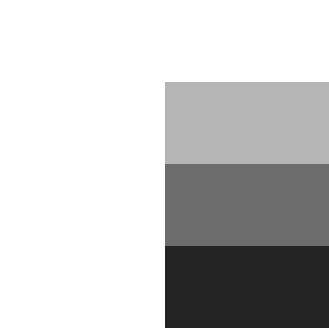BLACK LEVEL ADJUSTMENT


The black level (brightness) adjustment is simultaneously with the gray
scale adjustment the most important adjustment of a CRT displaying device.
Gray scale is normally set up by factory and should have been adjusted to
acceptable levels if you have purchased a brand name monitor. But the black
level is regularly misadjusted on every monitor since the control for it is
accessible by the user who has set it to his/her personal taste. What few
people know is that there exists an objective way of adjusting the black
level to the perfect setting. The black level is crucial for reproducing a
vivid and well-balanced picture on your monitor. Please follow the
guidelines on this page to achieve the best possible adjustment for your
monitor.
Quick Usage:
- Be sure that you have enough room lightning (room must not be dark).
- Warm up your monitor for at least 30 minutes before making this adjustment.
- Set the window size of your web browser to maximum (no background).
- Be sure to see the whole test patterns (scroll to the top if necessary).
- Notice the three vertical stripes at the left side:
- Turn the brightness control up until you can see three distinctive
vertical stipes labeled 1, 2 and 3. If you can not see all three
stripes, read the notes.
- Turn the control down slowly until the first stripe (1) starts to
fade away (i.e. the stripe becomes as black as the background).
- Now, turn the control up very carefully until the first stripe
becomes visible again.
- Set the white level (contrast) to your desired level but do not exceed the
peak linear operating range of your monitor (i.e. the point where the geometry
of your picture is getting distorted). Most modern monitors can be turned up
to the maximum white level without picture bending/distortion.
- Re-check the black level (brightness). It might have changed after having
adjusted the white level, since black and white level are interdependent.
- Now, your black level is correctly adjusted!
|
|

Notes:
-
The best stripe for setting up the black level is stripe 1. This is the
darkest possible gray. Then follows stripe 2 which is one step brighter and
stripe 3 which is again one step brighter. In any case you should use the
leftmost visible stripe for the black level adjustment.
-
When turning up your black level control you should see three distinctive
vertical stripes at the left side. If you can not see all stripes, your
system (graphics board, OS and browser) is not powerful enough to display
the dark (near to black) gray RGB values used on this adjustment page.
This means that you are working on an 8-bit screen (256 color screen). The color
accuracy on such a screen is very poor, since a defined color set is being used.
Colors that do not match the colors in the set are normally dithered to approach
the real color as close as possible. As this matching can be rather coarse your
system may decide to display several stripes as black as the background. This is
the reason why you might miss some stripes on an 8-bit screen.
Therefore you can find stripes 2 and 3 which are slightly brighter than stripe 1.
At least stripe 3 should be visible on your screen. If this is the case
perform the above adjustments with stripe 3 instead of stripe 1. If you can
see stripe 2 but not stripe 1, use stripe 2 for the adjustments.
-
If you use a graphics board which can display 15-bit/16-bit screen modes
(i.e. ~32000/64000 colors), use these color modes instead of only 8-bit
(256 colors). On an 8-bit screen you will never see the colors as they were
intended to be seen as the color accuracy is very poor due to a fixed color
look-up-table.
Technical note for experienced users: Even on 16-bit screens you won't
have perfect color fidelity, since the graphics board can only use
5/6/5-bits per RGB-gun. Only with 24-bit screens you will get true 8 bits
per gun color resolution. But this difference is so little in practical
situations that you won't notice the difference with real world graphics.
You might however experience the same problems as mentioned above, i.e.
that some of the three stripes are not visible. In this case use the
leftmost visible stripe.
-
You should set the window size of your web browser to the full dimension of
your screen, so that most of your screen is filled with the black
background of this adjustment page. Also consider that you should set the
black level in the usual ambient light environment that you are normally
working in. This is important since the correct perception of the black
level changes under different light conditions (it is absolutely normal
that when you switch off the room light after calibration and blank your
monitor with a screen blanker, you will perceive the black as not 100%
black). It should also be clear that you must not point direct light on
your monitor since you are thereby immensly compromising the black level
(and hence the overall picture reproduction) quality of your monitor.
-
On the right side you can see a combination of a logarithmic gray scale and
a white bar. These are important since they simulate the sum of an average
usage of bright parts in a displayed picture. To understand this you must
know that every HVPS (high voltage power supply) in a monitor is of
different quality. The HVPS is the "heart" of your monitor and amongst
other things responsible for holding a constant black level between different
picture contents. A more expensive HVPS will manage to hold the black level
both on a screen with very few bright contents and a screen with a lot of
bright elements on it. A cheap HVPS will not be able to do that, which
results in a loss of detail in darker areas of a displayed picture since
the black level drops when having too much bright elements on the
screen.
Therefore the black level should not be set on an almost dark screen, since
this is not the average usage of the monitor tube. The gray scale and the
white bar will assure that you will set the black level under normal
displaying conditions.
-
Please be sure that your monitor is already running longer than 30 minutes.
This is important since all CRT displaying devices need some time until
they reach their nominal performance (convergence, black and white level,
color temperature etc.)
Also be sure to scroll to the top of the page when making your adjustments.
You should be able to see the title "Black Level Adjustment". Read the
usage text before starting to make the adjustment since you will not see it
when scrolling up to the test patterns. It is important that the whole
test patterns come into view and are not covered or truncated by other
elements. Otherwise the black level adjustment will be compromised.
Thank you that you have read this far. You will soon realize that not only
the look of our website benefits from your adjusted monitor but also
other websites and your daily working environment will look better than
ever, especially if your black level was far from being perfectly adjusted.
|

|